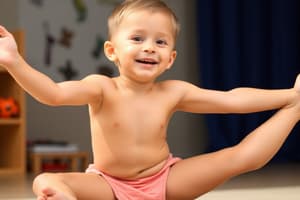Podcast
Questions and Answers
What does physical growth refer to?
What does physical growth refer to?
An increase in size or body mass resulting from an increase in complete, already formed body parts.
What does maturation refer to?
What does maturation refer to?
Progress towards physical maturity, the state of optimal functional integration of an individual's body systems and the ability to reproduce.
What does development refer to?
What does development refer to?
A continuous process throughout the life span. As age advances, development proceeds.
What does aging refer to?
What does aging refer to?
All change in movement constitutes development.
All change in movement constitutes development.
What is motor learning?
What is motor learning?
What does motor development refer to?
What does motor development refer to?
What are individual constraints and what are some examples?
What are individual constraints and what are some examples?
What are environmental constraints and what are some examples?
What are environmental constraints and what are some examples?
What are task constraints and what is an example?
What are task constraints and what is an example?
Which of these is considered a "Functional Constraint"?
Which of these is considered a "Functional Constraint"?
Flashcards
Physical Growth
Physical Growth
An increase in size or body mass resulting from an increase in complete, already formed body parts.
Maturation
Maturation
Progress towards physical maturity, a state where the body's systems work together optimally and the individual can reproduce.
Development
Development
A continuous process throughout life, involving changes in skills, abilities, and overall development.
Aging
Aging
Signup and view all the flashcards
Uniqueness
Uniqueness
Signup and view all the flashcards
Motor Learning
Motor Learning
Signup and view all the flashcards
Motor Control
Motor Control
Signup and view all the flashcards
Motor Development
Motor Development
Signup and view all the flashcards
Motor Behaviour
Motor Behaviour
Signup and view all the flashcards
Newell's Model
Newell's Model
Signup and view all the flashcards
Individual Constraints
Individual Constraints
Signup and view all the flashcards
Structural Constraints
Structural Constraints
Signup and view all the flashcards
Functional Constraints
Functional Constraints
Signup and view all the flashcards
Environmental Constraints
Environmental Constraints
Signup and view all the flashcards
Task Constraints
Task Constraints
Signup and view all the flashcards
Study Notes
KIN 3Q03 - Fundamental Concepts in Motor Development
- Course code: KIN 3Q03
- Textbook reading: Chapter 1
- Topics for MD Registration forms need to be approved; check MS Teams for updates
Table of Contents
- Definitions: Defines motor development, motor learning, motor control, maturation, and related concepts.
- Newell's Model: Describes constraints as a model for studying motor development.
- Developmental Trajectory: Describes a typical developmental trajectory.
- Research in Motor Development: Provides an overview of different types of studies in motor development.
Growth, Maturation, & Development
- Growth: Refers to an increase in size or body mass due to the formation of existing body parts. Occurs at the cellular level.
- Maturation: Refers to progress towards physical maturity, the optimal integration of body systems and the ability to reproduce.
- Development: Is a continuous process throughout the lifespan; progress continues as age advances; rates of change differ between individuals.
- Aging: Is the process associated with the passage of time, leading to loss of adaptability, full function, and ultimately death.
Individual Differences
- Uniqueness: Individuals function in diverse ways encompassing physical, social, cognitive, and psychological attributes. Predictable maturation, yet individuals are different; changes in movement do not automatically equate to development. Motor learning is a more apt term instead of development in these scenarios.
Motor Areas
- Motor Development: The continuous, age-related process of change in movement
- Motor Learning: Relatively permanent gain in motor skill capabilities through practice and experience.
- Motor Control: The study of neural, physical, and behavioural aspects of movement.
- Motor Behaviour: Used when not differentiating between motor learning and development, or to include both.
Constraints: A Model
- A model is beneficial for studying developmental changes throughout the lifespan.
- The model aids in incorporating relevant factors in observations of motor behaviour.
- Useful for understanding complex tasks and how skills constantly change.
- Helps categorize these changes.
Constraints' Model
- Karl Newell's 1986 Model: Consists of individual constraints, task constraints, environmental constraints, and interactions between these entities.
Constraints
- Individual Constraints: Person's unique physical and mental traits; factors like height, limb length, strength, and motivation influence movement.
- Structural Constraints: Related to body structure (e.g., height, weight, muscle mass, leg length); changes slowly over time.
- Functional Constraints: Related to behavioural function (e.g., motivation, fear, experiences, attentional focus); changes more rapidly.
- Environmental Constraints: External factors affecting movements (e.g., temperature, lighting, humidity, floor surface); exterior to the body.
- Task Constraints: Include goals and rules tied to particular movements (e.g. playing basketball – dribbling the ball). These are also external to the body.
Class Activity
- Consider factors affecting motor performance in activities like swinging a bat, snowboarding, and playing basketball (e.g., crowd noise, reaction time, fatigue, anxiety, injury risk, experience).
Reminders
- Complete weekly readings.
- Establish study partners to discuss the material.
- Submit registration forms promptly.
Questions?
- Contact Claire Tuckey at [email protected] for any questions.
Studying That Suits You
Use AI to generate personalized quizzes and flashcards to suit your learning preferences.




